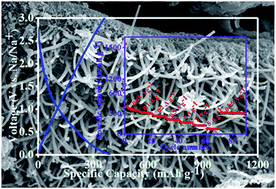Designing a slope-dominated hybrid nanostructure hard carbon anode for high-safety and high-capacity Na-ion batteries†
Abstract
Though high capacity and stable cycling of hard carbon anode Na-ion batteries have been achieved, critical safety issues, low discharge potential and unsatisfactory rate performance, present a huge challenge for their practical application. Herein, a slope-dominated mechanism strategy has been designed by preparing hybrid nanostructure carbon materials (HNCs) using a CVD-like method, providing hard carbon with excellent rate performances and high average discharge potential as an anode for Na-ion batteries. The HNCs integrate the advantages of carbon nanotubes and carbon nanosheets, presenting short ion/electron transfer distance and high surface area for abundant active sites. In addition, their microstructural properties including disorder degree and existing state of heteroatom sulfur, can be regulated via different synthetic temperatures providing effective nanovoids and bonding sites. Based on the reaction kinetics analysis, the Na-ion storage mechanism of HNCs can be determined as a capacitive-controlled process, which is essential for improving rate performances. This work demonstrates a novel method to develop a hybrid nanostructure hard carbon, and design of an electrochemical storage mechanism for high-performance and high-safety Na-ion batteries.

- This article is part of the themed collection: Journal of Materials Chemistry A HOT Papers


 Please wait while we load your content...
Please wait while we load your content...